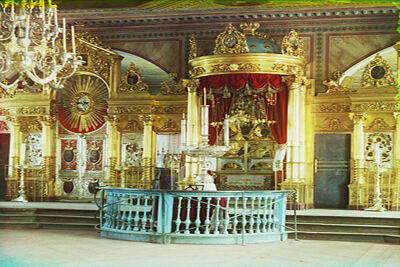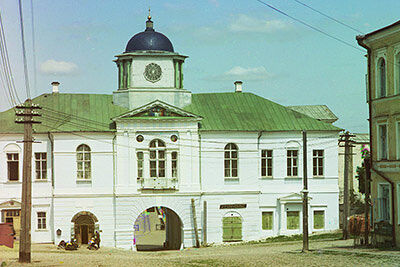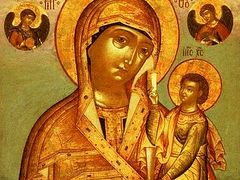The Smolensk Icon of the Mother of God Hodigitria (from the Greek: the “Wayshower”), now located in the Holy Dormition Cathedral of the city of Smolensk, is one of the greatest holy icons of Russia. This image is an exact copy of the ancient miraculous Smolensk icon of the Hodigitria, painted by the apostle and evangelist Luke.1 By the order of the outstanding Russian historian S.M. Solovyov, the icon of the Mother of God Hodigitria, which then became the “Gatekeeper”, was painted in 1535 in Moscow at the order of Tsar Ivan IV “the Terrible” by the artist Posnik Rostovets, for which he was granted “a purse worth two rubles and two more rubles in money”.2
Tsar Boris Godunov sent this icon to Smolensk in 1602 for the fortress wall built there in 1596–1602, the construction of which he supervised.3 The famous pre-revolutionary Smolensk historian I.I. Orlovsky writes about this event: “In the autumn of 1602, the wall was consecrated, and, on the main gates of the city, the Dnieper Gates, a large Hodigitria icon of the Mother of God, a copy of the cathedral icon sent from Moscow by Tsar Boris to Smolensk, was placed in a niche as an image of the patroness of the city and the heavenly guardian of the new fortress”.4 From its location—above the Dnieper Gates (otherwise known as Frolov Gates.—Auth.), this icon received the name “the Gate Icon”. The priest Nikifor Adrianovich Murzakevich in the “Historical description of the Miraculous Smolensk Hodigetria Icon of the Mother of God” written in 1831 indicates the dimensions of the Gate Icon of the Hodigitria—“two and a half arshins high [about six feet], one and a half arshins wide [about three feet”.5
 The Smolensk Icon of the Mother of God in the Church of the Mother of God over the Dnieper Gate in Smolensk. Photo: S.M. Prokudin-Gorsky, 1912
The Smolensk Icon of the Mother of God in the Church of the Mother of God over the Dnieper Gate in Smolensk. Photo: S.M. Prokudin-Gorsky, 1912
From the moment it was brought to Smolensk, the Gate Icon was constantly located in the Frolov Tower above the Dnieper Gate in a niche specially arranged on the side facing the city.6 In 1611–1654, when Smolensk was part of the Polish-Lithuanian Commonwealth, despite the forced Catholicization by the Poles of the local population, the icon remained in its place. It was in front of the Gate Icon of the Hodigitria that Tsar Alexei Mikhailovich, who joined Smolensk to the Moscow state, had the first moleben of thanksgiving served, and then solemnly entered the city on September 23/ October 6, 1654.7
The Patriotic War of 1812 was a time of universal glorification of the Smolensk Hodigitria Gate Icon of the Mother of God, which then became the patroness and guide of the entire Russian army.
Shortly after the invasion of Napoleon’s army into Russia, fierce battles for Smolensk began. On August 5/18, 1812, the enemy bombarded the city with 300 canons. However, the French nevertheless failed to capture Smolensk that day. The battle ended at 9 p.m. At midnight, General Dokhturov received an order from the commander-in-chief to leave Smolensk, which he executed two hours before dawn on August 6/19.8 By order of General Ermolov, the Smolensk Gatekeeper Icon of the Hodigitria Mother of God, which was at that moment in the Dormition Church, was taken out of the city. Ermolov himself subsequently wrote about it: “I ordered the image of the Smolensk Mother of God to be taken out of the city, hiding it from the outrages and desecrations [perpetrated by Napoleon’s soldiers] against the holy shrines. A prayer service was held, which produced a beneficial effect on the army”.9
 The Church of the Mother of God over the Dnieper Gate in Smolensk. Photo: S.M. Prokudin-Gorsky, 1912
The Church of the Mother of God over the Dnieper Gate in Smolensk. Photo: S.M. Prokudin-Gorsky, 1912
Another eyewitness to those events, officer F.N. Glinka, also left a description of the removal of the Gate Icon from the city: “In the deep twilight, the icon of the Smolensk Mother of God was taken out of the Dormition Church. The melancholy ringing of bells, merging with the crackling of falling buildings and the thunder of battle, accompanied this sad procession. The brightness of the fires illuminated it; meanwhile, a black and crimson cloud of smoke settled over the city, and night added darkness to darkness and horror to horror!!”10
The testimony of the British General Wilson, who was then in Smolensk, is also very interesting: “When I noted what a moral impression the abandonment of such a holy city as Smolensk would make in Russia, the commander-in-chief replied, “I’m not afraid of anything in this regard, I’ve already taken care of that. The Blessed Virgin is in our camp. Only this icon renders importance to this city in the eyes of Russians. She, in a solemn carriage, will constantly follow the troops, and she will be guarded especially by a designated battalion.”11
The escort of the Gate Icon of the Hodigitria was entrusted to Battery No. 1 Company of the 3rd Artillery Brigade under the command of Colonel V.A. Glukhov. This company was part of the 3rd corps of the 1st Army and took an active part in the battles near Smolensk on August 5/18. For the defense of the city, this company was first located in the Mstislav suburb, where it engaged in battle, but it was forced to retreat with other troops under enemy fire in order to occupy the next position at the Molokhovsky Gate. During the retreat, a French canon ball hit one of the ammunition cases of the 1st Battery Company. The explosion was such that only the bottom of the box remained. This box was preserved, and as in a chariot, the Gate Icon of the Mother of God was borne in it throughout her three-month stay in the Russian army.12
The sergeant major and the soldiers of Colonel V.A. Glukhov’s company, having taken over the icon, built a special wooden kiosk for it, which was painted green and bound with multicolored ribbons. Three or four days after leaving Smolensk, a special priest and deacon were appointed to accompany the Gate Icon of the Hodigitria, and they made prayers before her throughout the military campaign. From that moment on, the Smolensk Icon of the Mother of God was constantly among the Russian troops—in the third infantry division of Lieutenant General Konovnitsyn, strengthening and lifting the morale of our soldiers.13 Throughout the war, in addition to Colonel V.A. Glukhov, the icon consisted of: staff Captain I.F. Bogdanovich, lieutenant A.I. Grech, sub-lieutenants M.K. Rean, G.G. Sigunov, A.A. Olkhin, ensigns N.G. Sigunov and P.D. Zelenin.14
Archpriest P. Levashev in his short book, A Brief Legend about the Smolensk Hodigitria Icon of the Mother of God called the Gate Icon”, writes about the enormous significance of the presence of the Gate Icon of the Most Holy Theotokos in the ranks of the Russian army: “This holy icon was truly the only spiritual refuge for our pious army. Following the army everywhere, remaining with it in all times of hostilities, the Icon of the Mother of God Hodigitria was truly a Champion Leader for the Russian army and a guarantee of victory over our enemies. Every time, both before the beginning and at the end of the battle, the Heavenly Intercessor was a true refuge for all the participants of the battle; she gave them vigor and strength, motivated them, and served as a consolation for those dying on the battlefield in the final moments of life. The Russian soldiers’ firm and living faith in the heavenly intercession of the Mother of God, as if personally through Her miraculous icon in the Russian army, was able to give extraordinary strength and courage to Russian soldiers.”15
The apotheosis of the time of the Smolensk Icon of the Mother of God Hodigitria with the Russian army was the carrying of it by order of Commander-in-Chief M.I. Kutuzov throughout the army on the eve of the Battle of Borodino, on August 25/September 7, 1812. Solemnly, accompanied by a procession, the Smolensk icon was carried in front of the ranks of the entire army along the battle line of the Borodino position and molebens were served before it, one of which was prayed by M.I. Kutuzov himself with all the generals.16 Witness to this event, officer F. N. Glinka, wrote about it: “The clergy walked in their vestments, censers smoked, the air resounded with singing and the holy icon processed… At the impulse of the heart, the hundred thousand-strong army fell to their knees and with their foreheads to the ground, which was ready to drink its fill of their blood. The sign of the cross was being made everywhere, sobs were heard in places. The commander-in-chief, surrounded by his staff, met the icon and bowed to the ground before it.”17
On November 10/23, 1812, the Gate Icon of the Hodigitria Mother of God was returned to Smolensk.18 On this day, a member of the Smolensk Ecclesiastical Consistory, Archpriest Alexei Vasiliev, was invited to the commandant of the city, Major Gorikhvostov, to receive a special letter from the duty general of all armies, Lieutenant General Konovnitsyn, which read:
“On August 6 of this current year, when our troops abandoned the city of Smolensk, the holy miraculous icon of the Smolensk Mother of God was taken by an artillery company commanded by Colonel Glukhov, and since that time it has been carried with the regiments of the 3rd Infantry Division, which in all battles against the enemy guarded it in their ranks. The troops reverently gazed upon this image in their midst and considered it a favorable pledge of the Almighty’s mercy. When important victories and successes were won over the enemy, prayers of thanksgiving were always raised before the icon.
“Now, when Almighty God has blessed the Russian arms and the city of Smolensk has been cleansed by the defeat of the enemy, I, by the will of the commander-in-chief of all armies, His Excellency Field Marshal Mikhail Larionovich Golenishchev-Kutuzov, am sending the holy icon of the Smolensk Mother of God back. May it be installed in its former place, and may the Russian God be glorified in it, miraculously punishing at last the arrogant enemy [Napoleon] who has disturbed the peace of nations.
“Along with the icon are being sent contributions and offerings—1809 rubles, 5 gold pieces, and one pood [about 36 pounds] of silver scrap, recaptured from the enemy.”19
In sum, it can be said that during the Patriotic War of 1812, the whole of Russia prayed together with the Russian army before the Smolensk Gate Icon of the Hodigitria Mother of God. After all, behind the soldiers and officers who prayed to the Mother of God were their parents, wives and children, relatives and friends praying for them. And this prayer undoubtedly gave them firm hope of military success. With its presence, the Hodigitria icon poured courage into the hearts of the selflessly fighting Russian soldiers, being their guarantee of victory.




